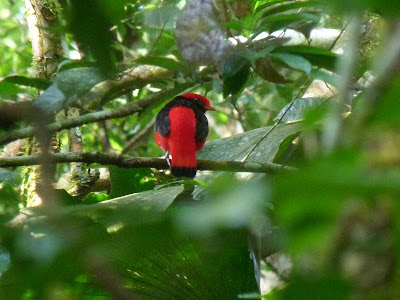It's been a while now since my last posting on colours in nature - red on that occasion - wherein I promised to get back to look at some of the many organisms, especially birds, which combine red and black to very striking effect. At least it's striking to our eyes, but we must assume that it is to other creatures as well, given its relative prevalence. Red is a colour intended to be seen; to attract a mate, to warn of the hazards of trying to eat the wearer, or in a plant to attract an animal to pollinate or distribute seeds in ripe fruit.
 |
| Masked Crimson Tanager Ramphocelus nigrogularis, Amazonia Lodge, Peru. In this species both sexes carry the bright colours, though the female is slightly duller. |
I think in the case of animals the combination with black is a variation on the theme, though in shadowy situations such as rainforest it presumably breaks up the outline and perhaps confuses predators for the essential extra second or so.
We know very little about this bird, though males seem to display. While there is some doubt about whether it's more closely related to cotingas or manikins, this does fit in with a pair of much better-known cotinga species, the cocks-of-the-rock. Here the males form a display lek, with the most successful birds taking the prized central positions, to where the waiting females head. Like the Black-necked Red Cotinga, she too is brown rather than red.
 |
| Andean Cock-of-the-Rock Rupicola peruvianus: males, Manu, Peru above; female, Aguas Calientes, Peru, below. |
It is significant that in many smaller red and black birds only the male is coloured; his job is to intimidate other males, impress females with his condition and his ability to survive despite being so conspicuous, and perhaps to distract predators from her, the nest and eggs. She has no need at all to be easily seen.
 |
| Scarlet Robin Petroica boodang, Canberra; male above, female below. The shot above doesn't show how black he is on top. |
Other examples of startlingly red and black males with brown-grey females follow.
 |
| Long-tailed Meadowlark Sturnella loyca, Chilean Patagonia. Male above, female below. |
 |
| Northern Red Bishop Euplectes franciscanus, Murchison Falls NP, Uganda. Not only are bishop and weaver females brown, but they are virtually indistinguishable from each other. |
 |
| Red-backed Fairy-wren Malurus melanocephalus, Ingham, Queensland. Like all fairy-wrens females, she is plain brown, whereas he glows through the scrub. |
On the other hand the females of some larger, more pugnacious species can afford to be as conspicuous as their blokes.
 |
| Papyrus Gonolek Laniarius mufumbiri, near Kagadi, Uganda. A bush-shrike, this is a notorious skulker, which is another reason for both members of the pair to be visisble. |
 |
| Magellanic Woodpecker Campephilus magellanicus,Torres del Paine NP, southern Chile. This is the male; she has less red in the head, but still stands out. This is a big, dramatic woodpecker! |
Examples of red and black in other organisms (and I'm limiting myself here to bright reds, not rusty or orange) are less easy to find.
 |
| Millipede, Mt Kupe, western Cameroon. Many millipedes taste bad, and I suspect that this one is emphasising the point. |
Nor can I find many plant examples, but I'm happy to go out today with one of my favourite Australian wildflowers, and the floral emblem of my birth-state, South Australia.
BACK ON SUNDAY







3 comments:
There's lots of red and black beetles and bugs in Europe. The bugs all probably taste bad, but I doubt all the beetles do. Ladybirds do I think. The corpse burying beetles Silphidae are often red and black (so you probably wouldn't want to be eating them), and a surprising number of longhorns (can't see any reason they would be poisonous, but many are conspicuous as adults), and there are many more in almost every family. I can also come up with red and black moths of several families (mostly poisonous), and a couple of red and black odonts (both sexes, and I wouldn't have thought poisonous).
A brightly coloured lark is a bit mind blowing!!
With insects I think a lot of colouring is bluff. In anthropomorphic terms the reasoning would be: "That red insect is poisonous and birds avoid it. So I'll be red as well and won't get chomped".
Martin
Perhaps some of my posts are driven too much by the available pics! Having said that I can't think of as many red and black insects here as you've enumerated for Europe Susan, but maybe that's just because you know more about it than I.
Don't let your mind explode excessively re the meadowlark though; it's not a lark at all, but an Icterid, or North American 'blackbird' - which aren't blackbirds either....
You raise a very good point too Martin; the whole topic of mimicry is a fascinating one. This aspect - palatable species resembling noxious ones for protection - is Batesian Mimicry (cf Mullerian Mimicry, where two or more noxious species resemble each other to reinforce the message). The problem comes when two many edible species use the ploy, so that the predator rarely encounters the model and doesn't associate the pattern with yukness; that way no-one wins. It was one of the things that got me intrigued by evolutionary processes too many decades ago...
Post a Comment